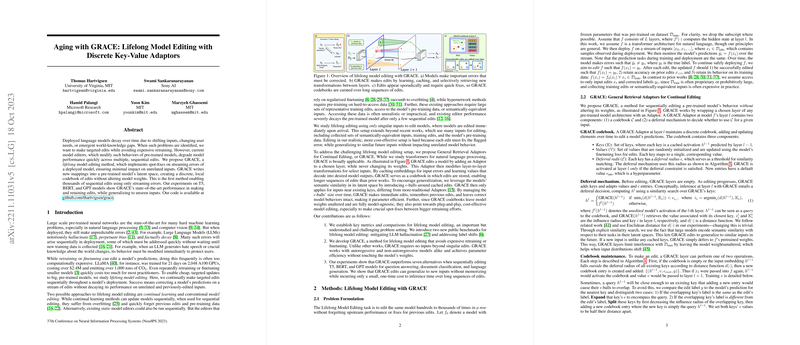Insights into GRACE: A Method for Lifelong Model Editing
The paper introduces GRACE, an innovative approach designed to address the limitations of traditional model editing techniques in the context of lifelong learning. GRACE serves as a method for model editing that facilitates targeted and efficient modifications to the behavior of pre-trained models over long deployment periods. Lifelong model editing has grown increasingly significant as LLMs encounter evolving inputs and shifting world knowledge post-deployment. With the prohibitive costs associated with constant retraining, GRACE provides a resource-conscious alternative that maintains model performance across numerous sequential edits.
The Problem Space
Large-scale pre-trained neural networks exhibit state-of-the-art performance in domains like NLP. However, the predominant challenge they face arises from real-world deployments where they manifest unpredictable behaviors—hallucinations, biases, and outdated factual knowledge being classic examples. Traditionally, rectifying such behaviors required retraining and fine-tuning mechanisms that are computationally expensive and environmentally taxing, posing impractical demands on smaller research teams or during fast-paced deployment phases.
The GRACE Methodology
GRACE stands for General Retrieval Adaptors for Continual Editing and introduces a paradigm where the neural network model’s weights remain unaltered. Instead, GRACE facilitates model editing by writing new mappings into the model's latent space through local, discrete codebooks of edits. This setup permits GRACE to embed thousands of sequential edits efficiently using streaming errors.
Key Components:
- Codebooks: At the core of GRACE are codebooks, which store keys (input instances' latent representations), values (output instances of desired transformations), and deferral radii (-balls for similarity-based generalization).
- Deferral Mechanism: GRACE includes a deferral mechanism that enables the model to either defer processing to the original pre-trained model or use the stored value for closely matching inputs.
This design choice allows GRACE to generalize edits to unseen inputs while leveraging the semantic proximity encoded within the model's latent representations. Moreover, by managing codebooks through carefully tuned deferral radii, GRACE minimizes the interference with unrelated inputs, thus addressing the challenge of catastrophic forgetting endemic in standard continuous learning settings.
Experimental Analysis and Results
The empirical validation of GRACE includes extensive testing on pre-trained models like T5, BERT, and GPT-2 across tasks related to question answering, document classification, and language generation. The performance was benchmarked against existing methods like MEND and Defer, alongside continual learning strategies such as EWC and finetuning variants, to highlight critical advantages of GRACE:
- Scalability: GRACE outperforms alternatives in terms of balancing edit retention (ERR) and training data retention (TRR), showcasing robustness over thousands of sequential edits.
- Resource Efficiency: It demonstrates superior performance with a fraction of learnable parameters, achieving significant parameter efficiency and rapid inference time, practically competitive with state-of-the-art baselines.
- Generalization: Impressively, GRACE's edits lead to better generalization on unseen data by efficiently leveraging internal semantic similarity.
The experimental results reveal that GRACE successfully remedies the previous inefficacies of static model editors in a continual learning setting. Its capability to facilitate nuanced edits, while retaining core model competencies, affirms GRACE as a significant step forward in the model adaptation landscape.
Implications and Future Directions
While presenting a formidable approach towards addressing crucial issues in model editing, GRACE introduces broader implications: its framework can seamlessly serve various sectors requiring dynamic adaptability in inference, such as robust personalization in recommendation systems or live adaptation in dialogue systems.
Looking forward, the plug-and-play nature of GRACE suggests exciting prospects—enabling on-demand tweakability without a full model reload—thereby fostering real-time adaptability with minimized ecological footprint. Further, the introduction of sophisticated codebook management and enhanced retrieval mechanisms might catalyze developments in building ever-evolving intelligent systems, bringing the ambition of autonomous, real-time model evolution closer to reality.
In conclusion, GRACE signifies a compelling contribution towards sustainable, scalable, and responsive model management, decidedly enriching the toolkit available for the community exploring transformative AI applications.
